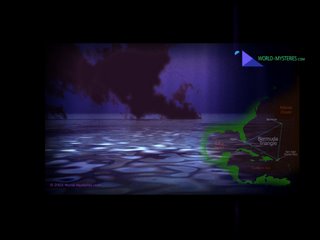The Bermuda Triangle

Back in the 1970s, before "The X-Files" made alien rectal probes the preferred departure point from consensus reality, there was the Bermuda Triangle.
The Bermuda Triangle (aka the Devil's Triangle) is a three-sided zone in the Atlantic Ocean stretching approximately from Miami, Fla., to Bermuda to San Juan, Puerto Rico.
Planes, boats and people go in to the Bermuda Triangle, and some of them don't go out. This in itself is not particularly remarkable. There are many places in the world which have the ethereal and mystical quality known in scientific circles as "being very dangerous."
No, the Triangle's claim to fame is pretty much centered on the particular penchant for the aforementioned boats and planes to disappear without a trace. No wreckage, no bodies, no survivors. Just "bye-bye to reality"..., which is the mantra we must utter before delving into the Triangle ourselves.
The historical root of the Bermuda Triangle legend dates back the time that superstitious Europeans first hit the Atlantic Ocean in their flimsy little boats. Columbus, sailing the ocean blue in (you guessed it) 1492, ran into a strange oceanic phenomenon known as the Sargasso Sea, which is not coincidentally located in the center of the triangle.
The Sargasso Sea was a large floating mass of seaweed that no one had ever seen the like of. It looked dangerous and entangling but was relatively innocuous in practice. Hordes of eels migrate there every year to mate and die, which also looked more dangerous than it actually was.
A legend of eerie splendiferous danger arose around the region of the Sargasso Sea, what with the tangling and eel-death-screwing. A diary entry from Columbus citing a light on the horizon has been expanded into a full-bore rectal probe chariot of fire by Triangle enthusiasts, but it's frankly underwhelming.
The next major incident chalked up to the Triangle's nefarious influence is the mysterious case of the Marie Celeste. In 1872, the Marie Celeste was found abandoned, as if the crew and passengers had very suddenly leapt up from their chairs and abandoned ship, leaving meals half-eaten and card games half-played.
What is especially mysterious about the case of the Marie Celeste is how it ever got attached to the Bermuda Triangle, since it set sail from New York and was discovered derelict in the Azores, which in scientific terms is "nowhere fuckin' close to" the Bermuda Triangle.
The modern version of the Bermuda Triangle story sprang not from the muck-covered, eel-spunk sea, but from the otherwise innocuous-seeming air. In 1945, the infamous Flight 19 set out on a training mission in the "triangle."
There were five Avenger bombers in Flight 19. A radio transmission indicated that the planes encountered problems with their compasses. The weather was reported to be inclement. The mission was never heard from again. A rescue plane sent out to look for the missing pilots was subsequently also lost without a trace.
Now, all this in itself is not particularly remarkable. Given the state of aerodynamic technology at the time and the weather conditions, the concept that the planes crashed at sea is basically sound. The failure to find any wreckage, while noteworthy, is also not especially profound, given that things tend to sink into the ocean, which is (in scientific terms) "very, very deep."
Over the next several years, various other planes and boats disappeared in the region, while other reported odd phenomena such as compasses going nuts. People occasionally reported seeing lights and spooky smoke.
All this made for the seeds of a nice, local ghost story, but not one of the great supernatural mysteries of our time. To elevate any single set of data to legendary status, one of two things is required: A genuine and profound mystery, or some one person who is willing to say there is a genuine and profound mystery loudly and repeatedly enough that people start to believe it.
According to the Navy's official statement on the Bermuda Triangle, "countless theories attempting to explain the many disappearances have been offered throughout the history of the area. The most practical seem to be environmental and those citing human error."
Bearing in mind that compass issues were the reported cause of the Flight 19 disappearance, the Navy points out that the Triangle is one of two regions in the world in which, by virtue of the curvature of the earth, compasses that point toward the magnetic North Pole also point "true north," to zero longitude, zero latitude. Normally, there is a significant variance between the compass direction "north" and "true north," and the phenomenon requires special calibrations for navigators. There's a similar region in the corresponding spot in the Eastern Hemisphere, also noted for disappearances.
According to the official statement, "The Coast Guard is not impressed with supernatural explanations of disasters at sea." - The Bermuda Triangle

















